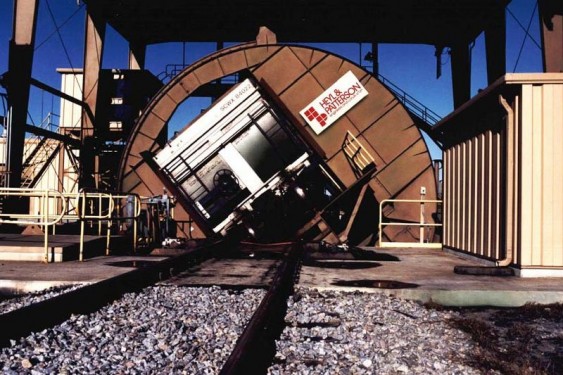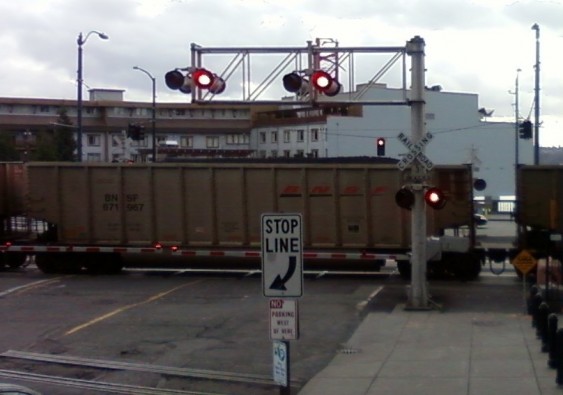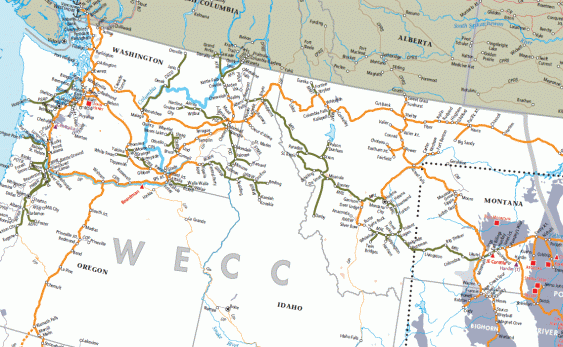Finally. Despite more than a year of research and writing on coal exports it wasn’t until yesterday that I saw my first loaded coal train. Here it is:
I snapped this photo while standing on Seattle’s Wall Street looking west toward the waterfront. Behind the coal train, you can see the Edgewater Hotel.
My first thought was should I stop breathing? Fortunately, coal dust was not visibly blowing off the tops of the coal cars. Unfortunately, however, the lopsided shape of the coal piles suggested that wind and rain had already taken their withdrawals somewhere along the tracks.
My second thought was: wow, global logistics are amazing. Although I think large-scale coal exports are a bad idea, there’s something undeniably gee-whiz about the path that coal was taking.
The coal almost certainly originated at the Spring Creek Mine, owned and operated by Cloud Peak Energy in southeastern Montana, not far from Sheridan, Wyoming. A few of the 230 workers there mined the coal using a “drag line open-pit” technique, similar to strip mining, that deploys a giant crane-like machine with a bucket for excavations. For a Powder River Basin deposit, the coal in my train was relatively high-energy and therefore relatively valuable. A typical pound of Spring Creek coal will yield an estimated 9,350 BTUs of heat when burned, about 9 percent more than average deposits in the Basin.
At the mine, the coal was loaded into open top hopper-style railcars on a BNSF train. If my train was a typical one, it was at least 100 cars long each of which carried perhaps 110 tons of coal. At the mine, the coal wasn’t worth much. Almost certainly priced at less than $15 per ton, the entire train’s worth of coal was worth less than $200,000 when it was loaded, though it would ultimately sell for much more than that in Asia.
After leaving the mine, the train took one of two main routes across Montana, either tracing a line through Great Falls-Whitefish-Libby (in yellow on the map) or through Bozeman-Helena-Missoula (in green on the map). In either case, the train arrived in Sandpoint, Idaho. From Sandpoint, it continued west to Spokane before traveling southwest to meet the Columbia River near Pasco. The train then turned west, rolling through the windy Columbia River Gorge to Vancouver, Washington where it turned north, paralleling Interstate 5 all the way to Seattle where I saw it on the waterfront. From Seattle it would continue north, passing through Everett and Bellingham and crossing the Canadian border at Blaine. Finally, it would turn west one last time and make its way to the Westshore Coal Terminal. All in all, it was a roughly 1,180 mile journey by rail.
By the time the coal reaches Westshore, it’s worth a lot more—in some sense. Figuring that shipping runs 1.5 cents per ton per mile, moving the coal from Wyoming to port in British Columbia adds costs of about $17.70 per ton, more than the coal was actually worth when it was mined.
In order to serve Westshore’s huge appetite for coal—the terminal may have exported as much as 25 million tons of coal in 2011—more than 1,800 trains like mine will arrive and depart in the course of a year. (The terminal itself puts the figure at closer to 2,200, which suggests smaller coal trains.) The vast majority of the coal arriving at Westshore, about 81 percent, comes from Canada; only about 19 percent of it takes the trip my coal did.
Once at Westshore, the train will be unloaded with a rather amazing piece of machinery called a “rotary dumper.” It will then be stockpiled, perhaps several times, using an even more amazing piece of equipment called a “stacker reclaimer.” Using a system of conveyor belts, the coal will eventually be loaded on an ocean-going vessel of huge proportions, likely a “Capesize” ship, the largest class of marine freighter.

It’s here where we lose sight of the coal in my train. We don’t know exactly where it will end up. What I’ve sketched out below, however, constitutes a reasonable assumption.
The coal ship will cross 5,100 miles of the Pacific Ocean, eventually arriving in port at Shanghai. In China the coal will sell for perhaps somewhere between $60 and $120 per ton. But now the costs are driven not primarily by the cost of shipping it, but by market prices in eastern China. Altogether then, the coal that passed me by on the waterfront could well be worth more than a million dollars.
The coal will be unloaded in China and then shipped by truck or rail to one of the many coal-fired power plants that generates electricity for the growing mega-city. If it’s burned in a relatively modern plant the coal will generate perhaps 34,000 megawatt-hours of power. That’s roughly as much power as 3,000 typical American homes use in a year.
Unfortunately, the combusted coal will produce more than just electricity. It will also emit more than 27,000 tons of carbon dioxide, the planet-warming equivalent of 6,100 American cars in a typical year. It will also produce nitrogen oxides, sulfur dioxide, and mercury. Some of that mercury will drift back across the Pacific, settling in places like Mount Bachelor in Oregon or Lake Washington near my home in Seattle.
In 2011, Cloud Peak shipped around 4.7 million tons of coal from the Powder River Basin to markets in Asia. If the Gateway Pacific Terminal is approved at Cherry Point, coal companies could soon be moving more than ten times that amount, 48 million tons, through northwest Washington. And if the Millennium Bulk Terminals project is approved in Longview, coal companies could soon be moving an additional 44 million tons of coal out of southwest Washington. And if the Port Westward and Morrow Pacific projects go forward at St. Helens, Oregon, coal companies could soon be moving an additional 38 million tons of coal out of northwest Oregon. Meanwhile, other plans are underway at Grays Harbor, Washington and Coos Bay, Oregon.
All in all, coal shipments in the Northwest could easily top 100 million tons per year. Before long, the coal train I was so startled to see on the waterfront will not be an oddity in Oregon and Washington, it will be a daily fact of life. Within a year or so, the Northwest will decide whether it will go from being virtually coal-free to joining the ranks of the world’s foremost coal dealers.
It’s not a future many in the Northwest had considered in the past. A region that prides itself on green energy, new economy jobs, and a clean environment is about to crown a new king—coal.




Comments are closed.